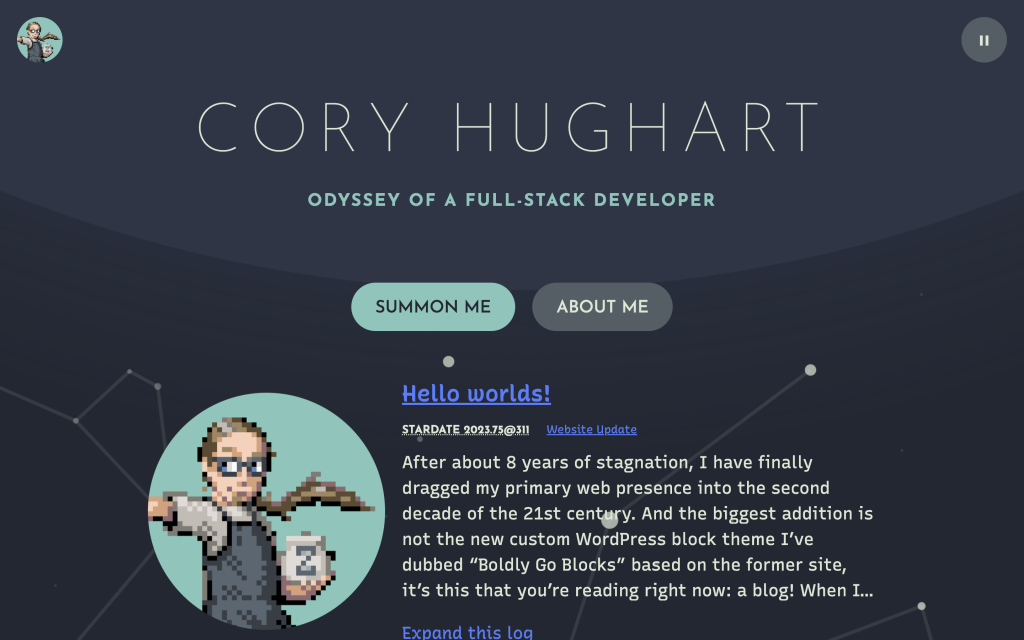

After about 8 years of stagnation, I have finally dragged my primary web presence into the second decade of the 21st century. And the biggest addition is not the new custom WordPress block theme I’ve dubbed “Boldly Go Blocks” based on the former site, it’s this that you’re reading right now: a blog!
When I first put up a “portfolio” website back in 2012, it was static site built with HTML, CSS, and JavaScript. The idea of a blog didn’t even enter my mind until I began working with WordPress, which I would eventually build a new iteration of the site with. But I built that site to specifically be a portfolio, opting to use the default post type for work samples—leaving little room for other kinds of posts.
I’m no stranger to blogging, but this is the first time I’ve committed to blogging on main. I’ve been running a blog called Crock of Time since 2020 that logs my adventures in fermenting (and there’s a Discord if you’re into fermentation too). Prior to that I, like most millennials, dabbled in blogging on various platforms in my youth… which is likely the reason it took so long to start one up again. Thankfully, those old blogs have been wiped from the internet, being from a time before the internet started remembering everything.
“Why don’t you blog about that…?” it whispers…
Part of the reason it took so long to give this website a much-needed facelift is because I got the job I was looking for shortly after launching it in 2015, and I wasn’t actively looking for work, freelance or otherwise. But since then, while learning and figuring out so many things, there’s been a quiet but persistent nagging voice echoing in the chasms of my mind. “Why don’t you blog about that…?” it whispers…
So here I am, finally blogging about it. I’m a little sad at the missed opportunity of years of accumulated knowledge locked away in my brain, faded and dusty—and, let’s be honest, probably mostly irrelevant now, but still. If the best time to start was years ago, the second best time is now.
Over the years, I’ve had many young web devs contact me to ask about how I built the site and/or general advice about portfolio websites. A fair majority of them were just enamored by the slowly rotating constellations at the top of the page, so I’ll point out here for the record that it’s just a big SVG positioned above the top of the site and set to rotate infinitely via CSS animation keyframes. I’ve seen so many portfolio websites that just use some goofy canvas animation in the header, most of the time stolen from CodePen, and I’ll tell you right now that no one is impressed by those. My advice is and always has been to do your own thing, make it unique and special. Yes, that is hard, but you’ll learn something about your intended profession and likely about yourself in the process; I know I did.
You know how it is, revisiting code you wrote a year ago—what an awful experience, 0 out of 10, would not recommend.
Another reason it took so long to update this site is that it was all locked up in old custom theme code. You know how it is, revisiting code you wrote a year ago—what an awful experience, 0 out of 10, would not recommend. I learn something new on every project, sometimes on purpose, which is why I’ve developed and maintained two different theme scaffolds during my time at Blackbird, one pre- and one post-Gutenberg (particularly post-theme.json). The current open-source scaffolding might already be showing it’s age as a hybrid theme scaffold in the age of the block theme (AKA full site editing), but the main purpose was to build something that separates the boilerplate code from the workflow (which became gulp-wp) so that at least some part of the codebase could be maintained & updated separately. Maybe the next one will include a framework that is installable via composer… Anyways, after a few successful experiments with block themes, I was ready to go all-in for my own site to both future-proof it for all the amazing features coming from Gutenberg as well as making it easier to customize without touching the theme code.
I plan on doing some in-depth posts about aspects of this new theme and how I accomplished them. If you see anything in particular you’d like explained, let me know in the comments below.